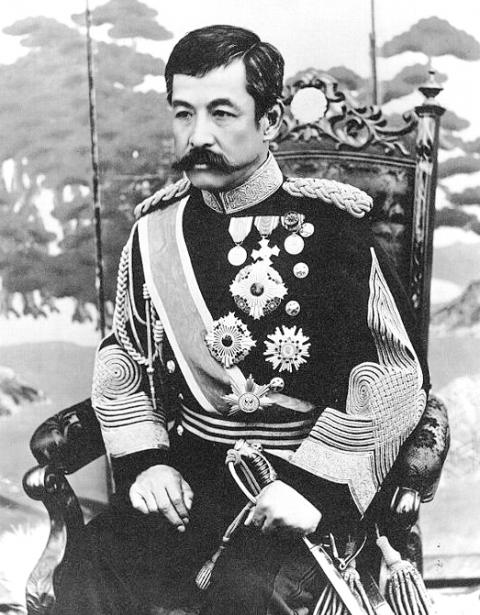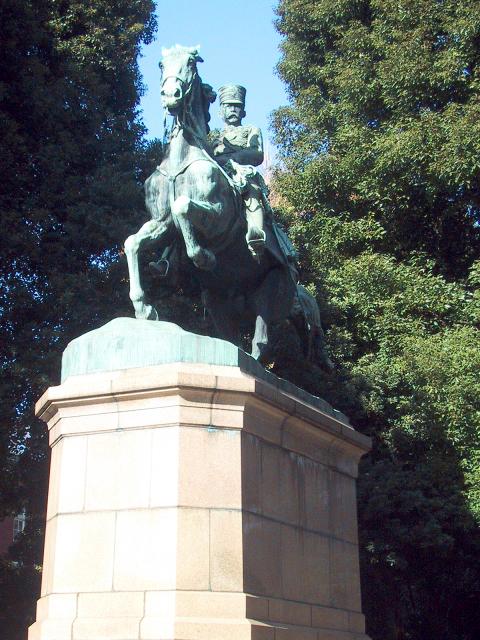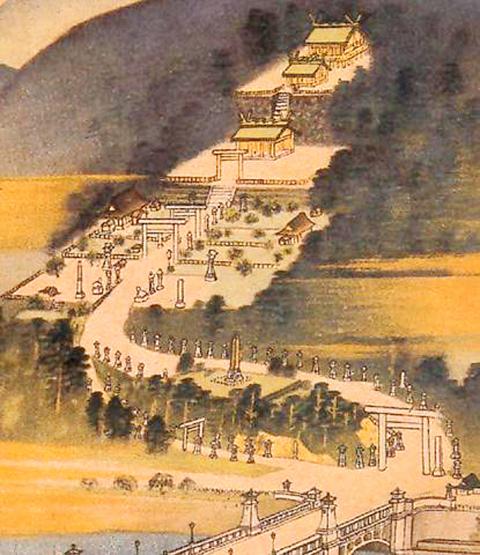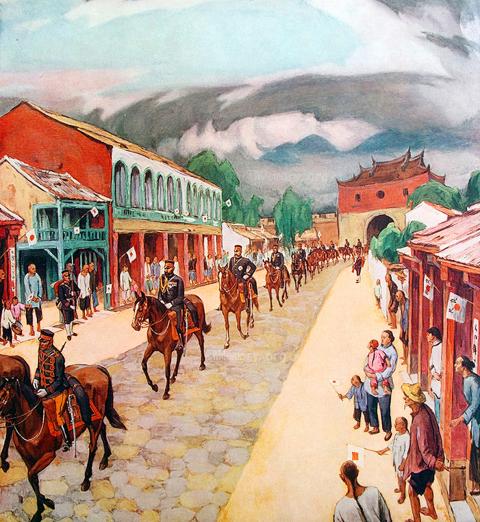May 27 to June 2
It was drizzling on the beach when Prince Kitashirakawa Yoshihisa landed in today’s Gongliao District (貢寮) on the northeastern coast of Taiwan.
According to Japanese army photographer Makoto Endo, he sat on a “strange looking chair” planted in the sand as Admiral Sukenori Kabayama addressed the royal, who was only distantly related to the emperors but attained his status through former emperor Kokaku adopting his father.

Photo courtesy of Wikimedia Commons
While the Qing Empire had ceded Taiwan to Japan, the Taiwanese weren’t about to go down without a fight. There had already been a skirmish two days earlier before Yoshihisa’s fleet landed on May 31, 1895, and the war would go on for another six months as the Japanese encountered fierce resistance in their march south.
Kabayama ordered his men to drive stakes into the sand to record the exact spot where the prince landed, so a monument could be built there after the war. Today, it has been replaced by the Yanliao Resistance Monument to commemorate the Taiwanese who died protecting their homeland.
There are varying theories as to what exactly happened, but Yoshihisa would not survive the war. He died in late October, and was later elevated to a deity and was worshipped in Shinto shrines across Taiwan, while the colonial government erected monuments at a number of sites he is said to have passed through.

Photo courtesy of Wikimedia Commons
SUCCUMBING TO MALARIA
There are many accounts of Yoshihisa being wounded or killed at various places around Taiwan by the resistance militias. Some say he died after being shot near Hsinchu, and it was his brother who pretended to be him and continued to push southward. But Japanese accounts agree that he died of illness.
After fighting their way into Changhua in late August, Yoshihisa’s troops remained in the area for a whole month due to malaria. Countless soldiers were infected and several high-ranking officers died. But Yoshihisa remained in good health as they started moving south.

Photo courtesy of Wikimedia Commons
Chief medical officer Tadanori Ishiguro’s account notes that Yoshihisa complained of bad appetite and feeling cold on their way from Chiayi to Tainan on Oct. 18.
That night, Yoshihisa came down with a 38.4 degree fever and showed symptoms of malaria, but insisted on pressing on. There had been fierce fighting between the Japanese and civilian militias in the area, and the party could hear cannon fire. Yoshihisa’s fever was at 40 degrees by the morning of Oct. 20, and he asked to be carried on a stretcher.
By this time, Liu Yung-fu (劉永福), who was supposed to defend Tainan on behalf of the official Republic of Formosa resistance forces, fled to China without even putting up a fight. The local elites and British missionaries decided to invite the Japanese into the city to avoid further bloodshed.

Photo courtesy of Wikimedia Commons
On Oct. 27, Kabayama reported to the prince: “Thanks to the outstanding service of the Imperial Japanese Army you were leading, Tainan has been pacified. Your highness, your mission has been accomplished.”
Yoshihisa died that night. The Japanese kept his death a secret, proclaiming that he was to be sent home to treat his illness. His coffin arrived in Japan on Nov. 4, upon which he was posthumously promoted to general.
FROM PRINCE TO GOD
Official records show that there were 60 Shinto shrines in Taiwan worshipping Yoshihisa by the end of Japanese rule in 1945.
In 1897, the Governor-General’s Office set up a committee to build a shrine for Yoshihisa. The Taiwan Grand Shrine was dedicated on Oct. 27, 1901, on the sixth anniversary of Yoshihisa’s death. In 1903, part of the funds allocated to the shrine were used to publish A Brief Account of the Taiwan Campaign, which painted Yoshihisa as a tragic hero who greatly contributed to Japan’s pacification of Taiwan. This book was distributed to schools across Taiwan to solidify this image.
Wu Pei-chen (吳佩珍) writes in The Prince Kitashirakawa and Colonial Taiwan (明治敗者史觀與殖民地台灣) that far more biographies of Yoshihisa were published in Taiwan than Japan, despite the man only spending six months in the colony. He was the figurehead of the losing side of the Japanese Revolution in 1868, at one point forced to become a monk in a temple — and the government likely wanted to obscure that part of history.
In 1911, an exhaustive biography of Yoshihisa was serialized in the national Taiwan Daily News (台灣日日新報), running for 10 months. His birth was embellished with supernatural details, further justifying his status as deity. As a royal who gave his life for the conquest of Taiwan, he became the symbol of Japanese rule, and shrines worshipping him continued to pop up with the government establishing monuments at the places he is said to have passed through.
Then-crown prince Hirohito visited the Taiwan Grand Shrine during 1923, and it is said that Yoshihisa’s consort would visit Taiwan every three years to mourn her husband. Furthermore, Oct. 28 was made a public holiday so Taiwanese could pay their respects at the shrine, further consolidating Yoshihisa’s divine status.
All shinto shrines were promptly decommissioned and became state property after the Chinese Nationalist Party (KMT) took over Taiwan. The Taiwan Grand Shrine was razed to build a hotel, which was later remodeled into today’s Grand Hotel. But many others still stand as historic monuments, and traces of Prince Kitashirakawa Yoshihisa can still be found across Taiwan, whether in monuments, landmarks or local folklore.
Taiwan in Time, a column about Taiwan’s history that is published every Sunday, spotlights important or interesting events around the nation that have anniversaries this week.

On April 26, The Lancet published a letter from two doctors at Taichung-based China Medical University Hospital (CMUH) warning that “Taiwan’s Health Care System is on the Brink of Collapse.” The authors said that “Years of policy inaction and mismanagement of resources have led to the National Health Insurance system operating under unsustainable conditions.” The pushback was immediate. Errors in the paper were quickly identified and publicized, to discredit the authors (the hospital apologized). CNA reported that CMUH said the letter described Taiwan in 2021 as having 62 nurses per 10,000 people, when the correct number was 78 nurses per 10,000

As we live longer, our risk of cognitive impairment is increasing. How can we delay the onset of symptoms? Do we have to give up every indulgence or can small changes make a difference? We asked neurologists for tips on how to keep our brains healthy for life. TAKE CARE OF YOUR HEALTH “All of the sensible things that apply to bodily health apply to brain health,” says Suzanne O’Sullivan, a consultant in neurology at the National Hospital for Neurology and Neurosurgery in London, and the author of The Age of Diagnosis. “When you’re 20, you can get away with absolute

May 5 to May 11 What started out as friction between Taiwanese students at Taichung First High School and a Japanese head cook escalated dramatically over the first two weeks of May 1927. It began on April 30 when the cook’s wife knew that lotus starch used in that night’s dinner had rat feces in it, but failed to inform staff until the meal was already prepared. The students believed that her silence was intentional, and filed a complaint. The school’s Japanese administrators sided with the cook’s family, dismissing the students as troublemakers and clamping down on their freedoms — with

As Donald Trump’s executive order in March led to the shuttering of Voice of America (VOA) — the global broadcaster whose roots date back to the fight against Nazi propaganda — he quickly attracted support from figures not used to aligning themselves with any US administration. Trump had ordered the US Agency for Global Media, the federal agency that funds VOA and other groups promoting independent journalism overseas, to be “eliminated to the maximum extent consistent with applicable law.” The decision suddenly halted programming in 49 languages to more than 425 million people. In Moscow, Margarita Simonyan, the hardline editor-in-chief of the